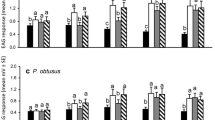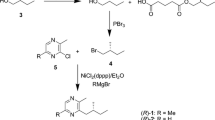Abstract
Alarm pheromones in social insects are an essential part of a complex of pheromone interactions that contribute to the maintenance of colony integrity and sociality. The alarm pheromones of ants were among the first examples of animal pheromones identified, primarily because of the large amount of chemical produced and the distinctive responses of ants to the pheromone. However, the alarm pheromone of the fire ant, Solenopsis invicta, eluded identification for over four decades. We identified 2-ethyl-3,6-dimethylpyrazine as an alarm pheromone component of S. invicta. Worker fire ants detect the pyrazine alarm pheromone at 30 pg/ml, which is comparable to alarm pheromone sensitivities reported for other ant species. The source of this alarm pheromone are the mandibular glands, which, in fire ants, are not well developed and contain only about 300 pg of the compound, much less than the microgram quantities of alarm pheromones reported for several other ant species. Female and male sexuals and workers produce the pyrazine, which suggests that it may be involved in fire ant mating flight initiation, as well as the typical worker alarm response. This is the first report of 2-ethyl-3,6-dimethylpyrazine from a Solenopsis species and the first example of this alkaloid functioning as an alarm pheromone.





Similar content being viewed by others
References
Alonso L. E. and Vander Meer R. K. 1997. Source of alate excitant pheromones in the red imported fire ant, Solenopsis invicta (Hymenoptera: Formicidae). J. Insect Behav. 10:541–555.
Banks W. A., Lofgren C. S., Jouvenaz D. P., Stringer C. E., Bishop P. M., Williams D. F., Wojcik D. P., and Glancey B. M. 1981. Techniques for collecting, rearing, and handling imported fire ants. USDA, SEA, AATS-S-21, 9 p.
Barlin M. R., Blum M. S., and Brand J. M. 1976. Fire ant trail pheromones: Analysis of species specificity after gas chromatographic fractionation. J. Insect Physiol. 22:839–844.
Billen J. P. J. 1990. A survey of the glandular systems of fire ants. pp. 85–94, in R. K. Vander Meer, K. Jaffe, A. Cedeno (eds.). Applied Myrmecology: A World Perspective. Westview, Boulder, xv + 741 p.
Billen J. and Morgan E. D. 1998. Pheromone communication in social insects: sources and secretions, pp. 3–33, in R. K. Vander Meer, M. D. Breed, K. E. Espelie, M. L. Winston (eds.). Pheromone Communication in Social Insects Ants, Wasps, Bees, and Termites. Westview, Boulder.
Blum M. S. 1980. Pheromones of adult fire ants (Solenopsis spp.). Proc. Tall Timbers Conf. Ecol. Anim. Control Habitat Manage. 7:55–60.
Brand J. M. 1978. Fire ant venom alkaloids: their contribution to chemosystematics and biochemical evolution. Biochem. Syst. Ecol. 6:337–340.
Buttery R. G. and Ling L. C. 1997. 2-Ethyl-3,5-dimethyl and 2-ethyl-3,6-dimethylpyrazine: Odor thresholds in water solution. Lebensm.-Wiss. u.-Technol. 30:109–110.
Cavill G. W. K., Robertson P. L., Brophy J. J., Duke R. K., Mcdonald J., and Plant W. D. 1984. Chemical ecology of the meat ant, Iridomyrmex purpureus sens. strict. Insect Biochem. 14:505–513.
El-sayed A. M. 2009. The Pherobase: Database of Insect Pheromones and semiochemicals. http://www.pherobase.com.
Escoubas P. and Blum M. S. 1990. The biological activities of ant-derived alkaloids, pp. 482–489, in R. K. Vander Meer, K. Jaffe, A. Cedeno (eds.). Applied Myrmecology: A World Perspective. Westview, Boulder
Glancey B. M., Rocca J., Lofgren C. S., and Tumlinson J. 1984. Field tests with synthetic components of the queen recognition pheromone of the red imported fire ant, Solenopsis invicta. Sociobiology 9:19–30.
Hölldobler B. and Wilson E. O. 1990. The Ants. Harvard University Press, Cambridge, xii + 732 p.
Jouvenaz D. P., Lofgren C. S., Carlson D. A., and Banks W. A. 1978. Specificity of the trail pheromones of four species of fire ants, Solenopsis spp. Florida Entomol. 61:244.
Longhurst C., Baker R., Howse P. E., and Speed W. 1978. Alkylpyrazines in ponerine ants: their presence in three genera, and caste specific behavioural responses to them in Odontomachus troglodytes. J. Insect Physiol. 24:833–837.
Macconnell J. G., Blum M. S., and Fales H. M. 1971. The chemistry of fire ant venom. Tetrahedron Lett. 26:1129–1139.
Markin G. P., Dillier J. H., Hill S. O., Blum M. S., and Hermann H. R. 1971. Nuptial flight and flight ranges of the imported fire ant, Solenopsis saevissima richteri (Hymenoptera: Formicidae). J. Georgia Entomol. Soc. 6:145–156.
Morgan E. D., Do Nascimento R. R., Keegans S. J., and Billen J. 1999. Comparative study of the mandibular gland secretion of workers of ponerine ants (Hymenoptera: Formicidae). J. Chem. Ecol. 25:1395–1410.
Obin M. S. and Vander Meer R. K. 1985. Gaster flagging by fire ants (Solenopsis spp.): Functional significance of venom dispersal behavior. J. Chem. Ecol. 11:1757–1768.
Obin M. S. and Vander Meer R. K. 1994. Alate semiochemicals release worker behavior during fire ant nuptial flights. J. Entomol. Sci. 29:143–151.
Phillips ,S. A., Jr. and Vinson S. B. 1980. Comparative morphology of glands associated with the head among castes of the red imported fire ant, Solenopsis invicta Buren. J. Georgia Entomol. Soc. 15:215–226.
Regnier F. E. and Wilson E. O. 1968. The alarm-defense system of the ant Acanthomyops claviger. J. Insect Physiol. 14:955–970.
Regnier F. E. and Wilson E. O. 1969. The alarm-defense system of the ant Lasius alienus. J. Insect Physiol. 15:893–898.
Ross K. G., Vander Meer R. K., Fletcher D. J. C., and Vargo E. L. 1987. Biochemical phenotypic and genetic studies of two introduced fire ants and their hybrid (Hymenoptera: Formicidae). Evolution 41:280–293.
Vander Meer R. K. 1986. The trail pheromone complex of Solenopsis invicta and Solenopsis richteri. In: C. S. Lofgren, Vander Meer R. K. (eds.). Fire Ants and Leaf Cutting Ants: Biology and Management. Boulder, CO. 435 p.: Westview Press. p 201–210.
Vander Meer R. K. 1988. Behavioral and biochemical variation in the fire ant, Solenopsis invicta, pp. 223–255, in R. L. Jeanne (ed.). Interindividual Behavioral Variability in Social Insects. Westview, Boulder, 456 p.
Vander Meer R. K. and Alonso L. E. 1998. Pheromone directed behavior in ants, pp. 159–192, in R. K. Vander Meer, M. Breed, M. Winston, K. E. Espelie (eds.). Pheromone Communication in Social Insects. Westview, Boulder, 368 p.
Vander Meer R. K. and Alonso L. E. 2002. Queen primer pheromone affects conspecific fire ant (Solenopsis invicta) aggression. Behav. Ecol. Sociobiol. 51:122–130.
Vander Meer R. K. and Lofgren C. S. 1988. Use of chemical characters in defining populations of fire ants (Solenopsis saevissima complex) (Hymenoptera: Formicidae). Fla. Entomol. 71:323–332.
Vander Meer R. K., Slowik T. J. and Thorvilson H. G. 2002. Semiochemicals released by electrically stimulated red imported fire ants, Solenopsis invicta. J. Chem. Ecol. 28:2585–2600.
Vargo E. L. 1998. Primer pheromones in ants, pp. 293–313, in R. K. Vander Meer, M. D. Breed, K. E. Espelie, M. L. Winston (eds.). Pheromone Communication in Social Insects Ants, Wasps, Bees, and Termites.Westview, Boulder.
Wilson E. O. 1958. A chemical releaser of alarm and digging behavior in the ant Pogonomyrmex badius (Latreille). Psyche 65:41–51.
Wilson E. O. 1962. Chemical communication among workers of the fire ant Solenopsis saevissima (Fr. Smith). 3. The experimental induction of social responses. Anim. Behav. 10:159–164.
Acknowledgements
We thank M. Custer, T. Krueger, and D. Milne for technical support, and Drs. S Allan and S. D. Porter for critically reviewing the manuscript. We are grateful to Dr. Buttery for graciously providing synthetic samples of the two pyrazines.
Author information
Authors and Affiliations
Corresponding author
Rights and permissions
About this article
Cite this article
Vander Meer, R.K., Preston, C.A. & Choi, MY. Isolation of a Pyrazine Alarm Pheromone Component from the Fire Ant, Solenopsis invicta . J Chem Ecol 36, 163–170 (2010). https://doi.org/10.1007/s10886-010-9743-0
Received:
Revised:
Accepted:
Published:
Issue Date:
DOI: https://doi.org/10.1007/s10886-010-9743-0




